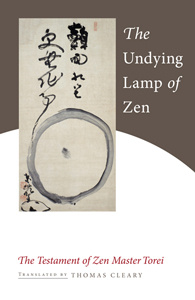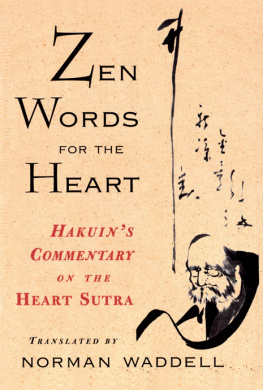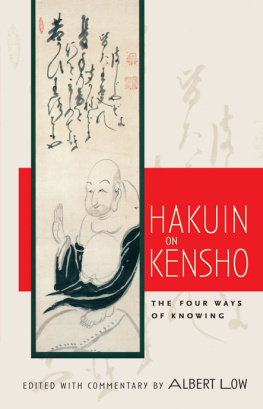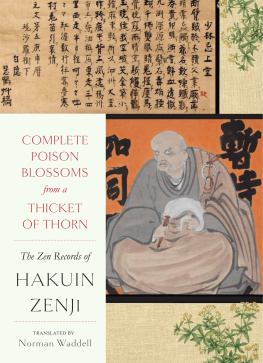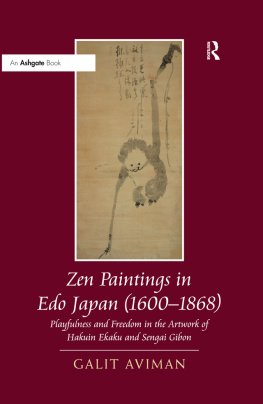


The Publisher is grateful for the support provided by Rolex Japan Ltd to underwrite this edition. And our thanks to Bruce R. Bailey, a great friend to this project.
Copyright 2017 by Norman Waddell
All rights reserved under International and Pan-American Copyright Conventions.
No part of this book may be used or reproduced in any manner whatsoever without written permission from the publisher, except in the case of brief quotations embodied in critical articles and reviews.
ISBN: 978-1-61902-931-6
THE LIBRARY OF CONGRESS CATALOGING-IN-PUBLICATION DATA
Names: Hakuin, 16861769, author.
Title: Complete poison blossoms from a thicket of thorn : the zen records of Hakuin Ekaku / Hakuin Zenji ; translated by Norman Waddell.
Other titles: Keiso dokuzui. English
Description: Berkeley, CA : Counterpoint Press, [2017]
Identifiers: LCCN | ISBN 9781619029316 (hardcover)
Subjects: LCSH: Zen BuddhismEarly works to 1800.
Classification: LCC BQ9399.E594 K4513 2017 | DDC 294.3/927dc23
LC record available at https://lccn.loc.gov/2017007544
Jacket designed by Kelly Winton
Book composition by VJB/Scribe
COUNTERPOINT
2560 Ninth Street, Suite 318
Berkeley, CA 94710
www.counterpointpress.com
Printed in the United States of America
Distributed by Publishers Group West
10 9 8 7 6 5 4 3 2 1
To the Memory of R. H. Blyth
C ONTENTS
COMPLETE POISON BLOSSOMS FROM A THICKET OF THORN
C HRONOLOGY OF H AKUINS L IFE
| 1685 | Born to the Nagasawa family of Hara, a village in Suruga province that served as a post station on the Tokaido road linking Edo and Kyoto |
| 169598 | Performs austerities and sutra recitations to allay fears of hell |
| 1699 | Ordained by Tanrei Soden at the Rinzai temple Shoin-ji next to the family home, receiving the name Ekaku, Wise Crane. Becomes student of Sokudo Fueki at Daisho-ji in Numazu |
| 170317 | Extended Zen pilgrimage around the central and western Japanese provinces |
| 1704 | Studies literature with Bao Rojin in Mino province |
| 1705 | Resumes pilgrimage; visits temples in western Japan and Shikoku |
| 1707 | Returns to Mino to nurse Priest Bao, devoting nights to zazen. At Shoin-ji during catastrophic eruption of nearby Mount Fuji |
| 170810 | Enlightenment at Eigan-ji in Echigo province. Deepens attainment with eight months of study under Shoju Rojin in Shinano province. Resumes pilgrimage; feels lack of freedom in everyday life. Zen sickness appears; he overcomes it using a therapeutic meditation learned from the hermit Hakuyu |
| 1712 | Nurses Sokudo, devotes spare moments to zazen and study of Zen records |
| 171314 | Visits Obaku priest Egoku; enters training hall of Inryo-ji, Soto temple in Izumi province |
| 171516 | Solitary practice at Mount Iwataki (Mino); returns at ailing fathers request to reside at Shoin-ji |
| 1717 | Installed as priest of Shoin-ji; continues post-satori training |
| 1718 | Adopts name Hakuin. Begins to lecture on Zen texts |
| 1726 | Experiences decisive enlightenment while reading Lotus Sutra |
| 172747 | Instructs students at Shoin-ji |
| 1740 | First large lecture meeting on the Record of Hsu-tang attended by four hundred people; recognized as a leading Zen teacher |
| 1743 | First book, Sokko-roku kaien-fusetsu, is published |
| 1747ca. 1760 | While teaching at Shoin-ji travels extensively to teach at other temples; publishes many works in Japanese and Chinese |
| 1751 | Lectures on Blue Cliff Record at Yogen-in subtemple of Myoshin-ji headquarters temple in Kyoto |
| 1758 | Publishes Gudos (Precious Mirrors) Lingering Radiance. Purchases Ryutaku-ji site in Mishima |
| 1759 | Poison Blossoms from a Thicket of Thorn and Supplement published this year or next |
| 1760 | Appoints Torei abbot of newly built Ryutaku-ji |
| 1763 | Physical debility increases |
| 1764 | Suio Genro installed as successor at Shoin-ji |
| 1766 | Announces will no longer receive students. Autobiographical Wild Ivy published |
| 1767 | Lectures on Poison Blossoms from a Thicket of Thorn at Ryutaku-ji |
| 1768 | Lectures on Supplement to Poison Blossoms from a Thicket of Thorn. Condition deteriorates; entrusts Suio with personal affairs; dies on eleventh day of the twelfth month |
I NTRODUCTION
T HIS BOOK IS a complete annotated translation of Poison Blossoms from a Thicket of Thorn (Japanese title: Keis dokuzui ), a work in nine volumes that contains oral and written teachings that Zen master Hakuin (16851768) delivered or otherwise presented to his students. It comprises material spanning a period of roughly fifty years, the earliest pieces from Hakuins mid-twenties, when he was still engaged in his Zen pilgrimage, and the latest from his early seventies, when Poison Blossoms was compiled. Two supplements are also translated, Supplement to Poison Blossoms from a Thicket of Thorn ( Keis-dokuzui shi ) and Guds Lingering Radiance ( Hkan Ish ), both published at around the same time as the main collection.
Iida Tin (18631937), one of the most highly respected Japanese Zen masters of the modern period, with strong roots in both St and Rinzai traditions, has this to say about Poison Blossoms:
Anyone who wants to understand Master Hakuin must read Poison Blossoms from a Thicket of Thorn . Half-baked Zen teachers who disparage Hakuin without having read it are like blind men groping at an elephant.... Although as the title indicates it contains much material that is extremely difficult to grasp, how can anyone claiming to be a descendant of Hakuin really know him unless he has read this work? I have always kept my own copy close at hand. It gives me the feeling that I am living together with the old master ( Zeny ni ataeru no sho, A Book for My Zen Friends, pp. 3056).
In addition to being the longest of Hakuins many publications, Poison Blossoms is arguably his most important as well. Statements Hakuin makes in his letters everyone is urging me to deliver lectures on my records in Kyoto [as soon as they are published].... It will help to make them more widely known are an indication of the high expectations he and his followers had for the work. The great effort he took to get it into print may also be seen to reflect an awareness of its significance as a literary legacy: a sense that this might be the work by which later generations would judge him.
Like his contemporary Samuel Johnson, who opined that every mans life can be best written by himself, Hakuin was apparently convinced that the surest way to guarantee that these important records of his teaching career were published in the right manner was to publish them himself. In contrast to most of Hakuins other writings, which were aimed primarily at his contemporaries, Poison Blossoms and the Chronological Biography of Zen Master Hakuin, both of which began being compiled in his seventies, can be said to have their sights on posterity.
Next page

